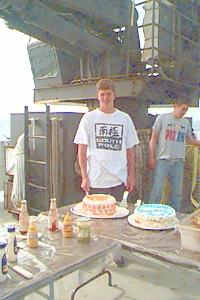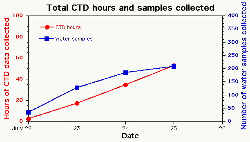| |
Science
Report:
Today on the
ship many of the scientists are trying to do an extra job in addition
to the busy schedule we usually maintain. We have scheduled time tomorrow
to replace the moorings that we recovered early in the cruise (it seems
like a long time ago to us, but it has only been nine days since the recoveries!).
So not only must they continue the hectic pace of data collection and
analysis, but several instruments must be prepared for their long stay
at the bottom of the ocean. Some of these instruments you have already
read about.
Sharon Walker is preparing
the MAPRs (or Miniature Autonomous Plume Recorders) that will monitor
the temperature and concentration of hydrothermal particles in the plumes
every hour for the next year. Geoff Lebon is readying a submersible pump
to take samples of the particles on the same kind of filters he's been
using during the cruise. The pump and electronics are in a stainless steel
cage as tall as a man. Every two weeks a computer in a pressure case turns
on the pump and sucks water through a filter, separating the tiny suspended
particles from seawater. Once a sample is collected a new filter rotates
into place above the pump and is ready for the next sample. These samples
will be used to examine changes in the kinds of minerals produced by the
hydrothermal venting on the seafloor.
Joe Resing will deploy
two "osmosamplers" on the moorings. These instruments use a unique system
that eliminates the need for battery power. They use osmotic pressure
to slowly and continuously draw seawater into a tiny tube. The samplers
have two chambers separated by a permeable membrane, one with a dense
salt solution and one with fresh water. As the fresh water slowly forces
its way into the salt solution to equalize the pressure between the two
chambers, it acts as a pump that also draws the outside seawater into
the sampling tube. By next year, the almost 100 m long tube will be full
of seawater, ready to be cut into pieces and analyzed to give a time series
record of changes in the local water chemistry.
Someday instruments may
be so sophisticated that scientists will no longer have to go to sea themselves--but
that's a long time away!
|
|

Reefdog Darin celebrating
his birthday with a cake from chief steward Lito and his crew.
(see the Teacher's log for details)

CTD work continues to collect samples.
(click for full size)
|
|

